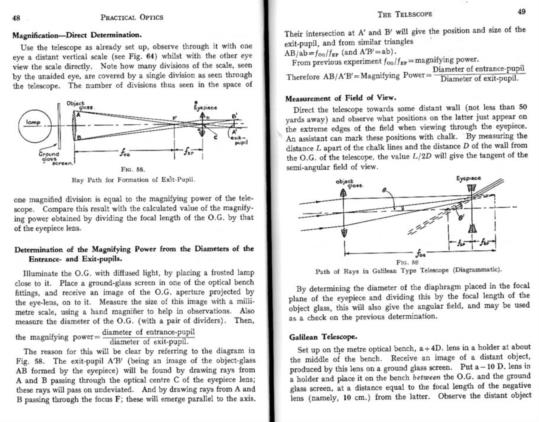
NavList:
A Community Devoted to the Preservation and Practice of Celestial Navigation and Other Methods of Traditional Wayfinding
Eyesight dangers using telescopes
From: George Huxtable
Date: 2009 Jun 26, 00:38 +0100
From: George Huxtable
Date: 2009 Jun 26, 00:38 +0100
Douglas Denny wrote- "Take my simple cheap binoculars. Magnification ten; objective aperture 50 mm; focal length of objective 195 mm, focal length of eyepiece 19.5 mm. The aperture of the exit pupil(x) is therefore:- x/19.5 = 25/214.5 which = 2.2 mm. real, and at 19.5 mm. from the eyepiece." ========================= I don't follow that. I wonder if Douglas is familiar with B K Johnson's little book "Optics and optical instruments". I attach a relevant page with a ray-diagram. According to that, the exit pupil would be the size of the objective divided by the magnification, which would come out as 5mm, not 2.2mm. It seems to make sense to me; but then I'm no expert on optics. If Douglas thinks that Johnson has it wrong, perhaps he will explain why, preferably with another ray-diagram.. However, it doesn't matter, not a bit. I have accepted, for the purposes of this argument, that the pupil stays wide open, despite the bright light, and that every bit of the sunlight that enters the objective passes, with 100% efficiency, through the pupil and into the eye. What more could Douglas ask for? And assuming that, then with a magnification of 10x, the amount of light entering the eye will be 100x greater than if the Sun is seen with the naked eye. Does he accept that? It's what happens next that matters. Does Douglas agree that the image of the unmagnified Sun (32' across) on the retina, taking the focal length of the eye to be 25mm, will be about 0.24mm diameter? That would correspond to a disc of area .045 square mm. Now look throgh the telescope. With a magnification of x10, the angular divergence of light from the sun is increased from 32' to 320'. And the light from that 10x larger disc paints an illuminated area on the retina that 10x greater in diameter, so now, it's 2.4mm. In which case, the area of that disc is increased by 100x compared with the naked eye case, to 4.5 square mm. So we have 100x as much light energy, falling on a disc that's 100x greater in area. Therefore, the energy density falling on any part of the disc is exactly the same as with the naked eye. Douglas appears to be unwilling to accept that analysis, so I ask him to identify which of those steps he disputes, and what he proposes in its place. George. contact George Huxtable, at george@hux.me.uk or at +44 1865 820222 (from UK, 01865 820222) or at 1 Sandy Lane, Southmoor, Abingdon, Oxon OX13 5HX, UK. --~--~---------~--~----~------------~-------~--~----~ Navigation List archive: www.fer3.com/arc To post, email NavList@fer3.com To , email NavList-@fer3.com -~----------~----~----~----~------~----~------~--~---







